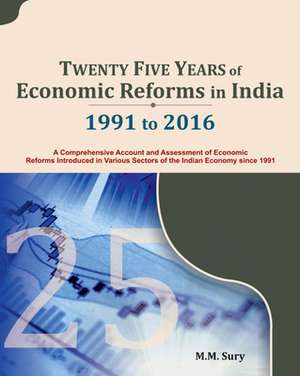Twenty Five Years of Economic Reforms in India: 1991 to 2016
Autor M. M. Suryen Limba Engleză Hardback – 12 aug 2016
Preț: 770.68 lei
Preț vechi: 866.96 lei
-11% Nou
Puncte Express: 1156
Preț estimativ în valută:
147.47€ • 153.97$ • 122.05£
147.47€ • 153.97$ • 122.05£
Carte indisponibilă temporar
Doresc să fiu notificat când acest titlu va fi disponibil:
Se trimite...
Preluare comenzi: 021 569.72.76
Specificații
ISBN-13: 9788177084344
ISBN-10: 8177084348
Pagini: 452
Dimensiuni: 190 x 250 x 2 mm
Greutate: 1.25 kg
Editura: New Century Publications
Colecția New Century Publications (IND)
ISBN-10: 8177084348
Pagini: 452
Dimensiuni: 190 x 250 x 2 mm
Greutate: 1.25 kg
Editura: New Century Publications
Colecția New Century Publications (IND)
Cuprins
Pre-reforms Period: 1947 to 1991; Post-reforms Period: 1991-2016; World Economy & India; Problems & Challenges before the Indian Economy; Future Prospects of the Indian Economy; Demise of Planning Commission & the Birth of NITI Aayog; Recent Policies & Programmes for Agricultural Development; Agricultural Inputs & Services; Digital Services for Agriculture & Rural Development; Diversification of Indian Agriculture; Rural Development & Services; Post-reforms Industrial Delicensing, Dereservation & New Initiatives; Public Sector Disinvestment; Promotion of Micro, Small & Medium Enterprises (MSMEs); Entrepreneurship Development & Innovations; Infrastructure Development & Upgradation; Changing Paradigm of Money & Monetary Policy; Government Budgeting Reforms; Rationalization & Simplification of Tax System 19.1 Income Tax Reforms; Centre-State & State-Local Financial Relations; Financial Institutions, Financial Markets & Financial Instruments; Financial Inclusion Measures; Micro Finance & Self-help Groups (SHGs); Financial Regulators in India; Employment Generation Programmes/Schemes; Labour Lawns & Trade Unions; Welfare Measures for Unorganized Workers; Health & Education; Social Security & Justice for Disadvantaged & Vulnerable Groups; Environment, Climate Change & Disaster Management; Post-liberalization (1991 onwards) Reforms in the Foreign Trade Sector 31.1 Lifting of Import Restrictions; Exports & Imports; Foreign Debt & Aid; Foreign Investment; Bibliography.
